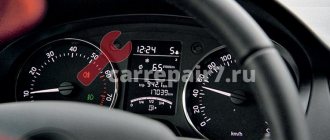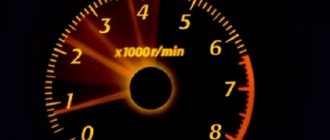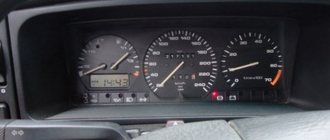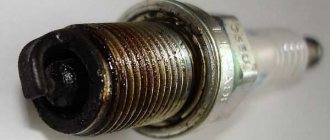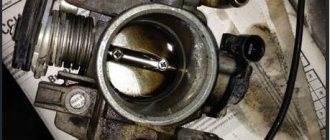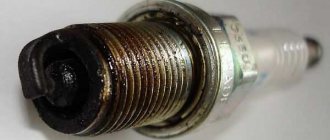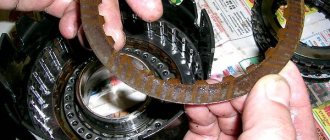03/04/2022 9 123 Consultation with a specialist
Author: Ivan Baranov
Good afternoon The 2.4 engine stalls when accelerating, it feels like the ignition is late. Help me please! (Magamed)
Hello, Magamed! There can be many reasons for this, ranging from compression and spent spark plugs to the fuel filter. Of course, the problem may also be late ignition. If you had indicated the make of your car, perhaps our recommendations would have been more accurate.
[Hide]
Causes of failures when pressing the gas pedal
The gas (accelerator) pedal is a control with which the driver doses the volume of the combustible mixture, which at that particular moment must enter the engine cylinders in order for the car to drive faster or slower, but several systems are responsible for the ratio of air and fuel (mixture quality) , controlled not by the driver, but by the “brain” of the car (ECU), or mechanics (carburetor).
Gas pedal
In a carburetor engine, this dosing is easier - the cross-section of the main jet opening through which gasoline passes becomes larger or smaller. If necessary, only the idle jet works; when you press the pedal, both work together. Next, the main thing for the engine is to ignite the mixture with a high-quality spark, and the required force to turn the crankshaft will be obtained.
In modern injection engines and diesel engines, changing the position of the gas pedal gives a command, before executing which, the electronic unit “checks” with the readings of pressure and temperature sensors, and with data. showing the speed of the crankshaft and camshafts, the volume of air consumed and the content of residual oxygen in the exhaust gases.
Failure when pressing the gas occurs if:
- Data from one or more sensors is incorrect, missing, or does not match the baseline.
- Electronics has accumulated a large number of critical errors (the dump and flash memory need to be rewritten).
- Something is preventing fuel from reaching the cylinders in full.
- Something makes it difficult for air to fully enter the cylinders.
- Something makes it difficult to evacuate the spent mixture into the exhaust manifold.
- One or more cylinders are misfiring.
- The spark does not ignite at a certain moment - the advance has been lost.
If the car is “old”, it will require comprehensive diagnostics, because the problem can be caused by all these reasons at the same time.
Injectors, intake and exhaust manifolds wear out and become clogged, Hall sensors and explosive wires fail due to age, compression decreases due to wear, springs and hydraulic compensators in the cylinder head get tired, and advance settings “float”. On cars with short mileage (up to 100 thousand km), one unit usually fails. During the runs before the second maintenance, most often a factory defect or a consequence of poor quality assembly “comes out”.
Is the engine running poorly? Main reasons
The dynamics of a car, first of all, depend on the stable and stable operation of the engine. When this characteristic decreases, it indicates that there are problems with the engine.
Engine VAZ-2114
Unstable engine operation is caused by the following:
- The fuel filter is dirty.
- The fuel pump diaphragm is clogged.
- The air filter is clogged.
- Spark plugs do not work or work poorly.
- Insufficient compression in the cylinders.
- The on-board computer is malfunctioning.
- The injectors are clogged (they need to be cleaned or replaced).
- The clutch disc is worn.
- Malfunctions in the operation of sensors that monitor: the position of the crankshaft, throttle valve; coolant temperature; air flow; detonation.
These are only some of the possible reasons why the engine may not pull well throughout the entire speed range.
It is worth mentioning the fuel pump, which fails. The real state of affairs is determined by detailed diagnostics.
Brief analysis of the causes and their consequences on the VAZ-2114
- Fine filter dirty. Determined visually. Debris particles present in the fuel tank and gasoline accumulate in the filter and the channels become clogged. There is not enough fuel supplied. “Treatment” – the filter is changed completely.
Changing the fuel filter
- The fuel pump diaphragm is clogged. The reason is the same, there are dirt particles in gasoline. Solved by excavation, washing, blowing with compressed air
Changing the fuel pump grid
- The air filter is clogged. For a short time, it can be solved by blowing out the filter, you can knock on a hard object. Ideally, the filter is replaced with a new one.
Clean or change the air filter
- Spark plugs do not work or work poorly. Determined by inspection after unscrewing. One of the reasons is non-compliance with the standards for the gap between the electrodes. The gaps are checked with a feeler gauge and the required one is installed. To do this, bend the side electrode to the required amount.
Checking the gap between the spark plug electrodes
- Heavy carbon deposits form on the spark plugs. The electrodes are sanded with sandpaper (zero), cleaned, and the gap is checked.
Cleaning spark plugs from carbon deposits
- The serviceability of spark plugs is checked on a stationary stand. If problems occur, it must be replaced.
It is best to check spark plugs at a stand in a car service center.
- Insufficient compression in cylinders. This defect appears as a result of high wear of the cylinder-piston group. The result is increased oil consumption, incomplete combustion of the combustible mixture, air leaks, and gasoline enters the crankcase. In some cases, it is enough to replace the piston rings, in others a major overhaul of the engine is necessary.
We measure the compression in each cylinder
- Failure or breakdown of the electronic control unit. Without special knowledge it is impossible to repair. Diagnostics are carried out using special devices. Re-flashing is possible, or the control unit can be completely changed.
We carry out diagnostics of the control unit
- The injectors are clogged. Cleaning (rinsing) is carried out at the stand with special solutions. There are fuel additives, but they don’t give much effect. It may be necessary to replace a faulty injector, so read the material: “which injectors are best installed on a VAZ-2114.”
You can clean injectors at home
- The clutch disc is worn out. While driving, when the speed increases, the car does not gain the required speed, and slipping is felt. It is checked by experts by starting off in fourth gear. If it stalls, everything is fine with the disk; if the engine is running, then there is a problem. Solved by replacing the clutch disc.
If the clutch disc is worn, we replace it
- Sensor malfunctions. Often there is a break in electrical circuits. This is a field of activity for electricians. The state of the sensors is monitored by the indicator light “ Check engine". Breaks are repaired or sensors are changed.
If the Check engine sensor lights up, it indicates a malfunction of the sensors.
How to understand why failure occurs when you press the accelerator
Often, the source of the problem is indicated by additional signs of a malfunction - for example, a “reluctant” engine start “on cold”, a general decrease in power (even before failures appear), increased fuel consumption. A very important criterion is when the problem manifests itself. If you notice that the engine spins up nonlinearly, as if there is a counterforce preventing it from gaining speed, most likely the reason is a clogged fuel or air filter. If the car “jerks” during acceleration with a smooth opening of the throttle, and, when pressed more intensely, it suddenly “shoots” - the jerks are associated with a lack of fuel. Dips during over-throttle and prolonged pressing and holding of the gas pedal, multiplied by difficult starting of a cold engine, indicate a malfunction of one or more spark plugs (and their coils).
Flooded or faulty spark plugs can also cause the gas pedal to fail.
The spark plugs that come with the car from the factory are more durable than most commercially available consumables, so it is recommended to do the second and subsequent replacements at shorter intervals.
Sometimes the problems of loss of throttle response, jerking, stepwise acceleration during acceleration are not at all related to the operation of the engine. On cars with automatic transmission, this is how severe wear appears. You will notice it when switching during acceleration - first a second delay without reaction to the gas pedal, then a push and acceleration. In cars with gas equipment, such a reaction to gas begins to occur when the gas reducer or its sensor breaks down. At the same time, the car begins to consume two to three times more gas. In diesel engines, an adequate response to vigorous pressing of the gas pedal is greatly impaired by refueling with low-quality fuel with a high sulfur content, or with a type of diesel fuel that does not correspond to the season.
And help me, please
Complete frequently asked questions for the site, for a section colloquially called FAQ or FAQ. What questions do you have? What's not clear?
Here are, for now, the most frequently asked questions, the answers to which are on the website:
- I have my own spare parts. Can you do some repairs?
— Is it possible to call your specialist “at home” or is it necessary to come to your auto repair center?
— I called you yesterday, and you named the price “From so many rubles.” Is it really difficult to name the exact amount?
— You have photos of certificates posted on your website. What does this mean – “certified auto repair shop”?
— How is the problem solved if the client is not satisfied with the quality of the work performed?
— Many car owners are chasing after original auto parts. Is there a technical difference between original and non-original and what do you use?
— What can your auto repair center recommend if a buyer decides to buy any of the used models?
- Tell me, I have a question about computer diagnostics of the engine - if you cannot find the cause of the car malfunction, no payment will be made for the service provided?
— When asked about the causes of the malfunction, I received a clear answer: replacement of the high-pressure hose. How can you make a diagnosis of a malfunction over the phone? Is this professionalism or p...?
— Is it possible to order original spare parts from you?
Gaps during acceleration
When accelerating a car, the load on the engine increases, which requires more fuel-air mixture, so most problems that cause failure during acceleration are associated with a lack of fuel or air. Check the condition of the fuel pump, filters, rail pressure, spark quality (in a gasoline engine). Changing the settings - mixture quality and ignition timing - is controlled by the electronics, so it is better to start diagnosing the problem by checking the dynamic indicators with a scanner directly during the trip.
Remember: if your car is equipped with an electronic “E-gas” pedal, there are usually three reasons that cause “failure” when you press it: shorted contacts, failure of the clutch and brake position sensor, or a system error.
When you press the gas pedal hard, used cars often experience a delay in the opening of the intake manifold flaps. This is a purely mechanical problem when, due to age and vigorous use, the collector becomes overgrown from the inside with a thick layer of soot “spitted out” by the cylinders of oil (and soot from the USR). The swirl flaps in the intake manifold can be cleaned or removed, just like the USR valve, but this must be done physically and programmatically, in a certified service center.
Main reasons
There are many reasons for this phenomenon and in most cases they are associated with a malfunction of the systems and mechanisms of the power plant.
Some of them are trivial and very easy to fix, others require quite serious repairs.
The main problem with the fact that the engine does not pull is not related to eliminating the malfunction, but to finding it.
In some cases, it is very difficult to determine what caused the reduction in traction effort and you have to go through almost the entire engine.
Therefore, we will try to indicate the main reasons why the car accelerates very “sluggishly”.
Since engines on different cars have their own design features, we will consider specific models.
Dips at idle
If the revolutions drop not when you press the gas pedal, but on their own - in the interval between starting the engine and completely warming up, you will need a good scanner to fully diagnose the cause. A problem that appears only on a cold or only on a hot engine may simply be a failure of electronic components. Among the sensors, the “champions” in terms of failures were: “brains” (control electronics unit), throttle position sensor, idle air control, intake air pressure and temperature sensors, flow meter.
Errors in the ECU are most often the cause of the gas pedal failing
Not all inconsistencies in indicators, loss of sensor signals, or open circuits cause errors on the instrument panel. Most pass without a trace, and only an experienced diagnostician will see them in the logs.
You can independently check for external air leaks, replace the air and fuel filters, change spark plugs, high-voltage wires, and coils. Measure compression in all cylinders. Inspect the engine head for oil leaks from under the crankcase ventilation valve - it may be clogged and will need to be washed or replaced. If you are not sure about the cleanliness of the tank and the quality of the fuel, drain it completely by washing the tank and the fuel pump sump.
Popular brands:
Renault Logan
Other reasons for reduced engine performance
The condition of the exhaust system also greatly influences engine power. The fact is that to protect the environment from harmful emissions during operation of the internal combustion engine, catalytic converters are installed in the exhaust.
During operation, the filter catalyst may be destroyed, reducing the throughput of the exhaust system. As a result, the engine is “strangled”. The check is carried out by measuring the pressure before and after the catalyst. You can also remove the element and inspect its condition visually.
As a rule, official services offer to replace a worn-out element, but the price of the spare part is very high. For this reason, on many cars in the CIS, the catalyst is simply knocked out, and the control unit is “deceived” by software or other available methods.
Also, when engine power decreases, it is necessary to separately check the installation of the timing belt or chain according to the marks in order to eliminate the possibility of valve timing failure. Sometimes there are situations when the belt can jump one tooth, the chain stretches, etc.
In this case, the synchronous operation of the valve mechanism in relation to the operating cycles of the internal combustion engine may be disrupted. This leads to various failures, unstable operation of the unit and reduced power.
Let us also add that engine wear and certain malfunctions also affect engine power. As a rule, worn-out internal combustion engines with mileage usually lose about 10% of their declared power.
If the driver feels that the losses are greater, then the engine needs
measure compression
. Low compression in the cylinders can occur as a result of wear of the cylinder walls, piston rings,
valve burnout
or their incomplete closure, etc.
One way or another, any leaks in the combustion chamber will lead to expanding gases breaking out of the cylinder during fuel combustion. This means that the pressure of these gases on the piston will decrease, and the internal combustion engine itself will draw poorly and operate unstably.
Finally, we note that the reason that the car has lost dynamics may not be the engine, but the transmission. In other words, the power unit develops enough power, but it is not fully transmitted to the wheels.
This usually manifests itself in the way that the engine roars, the speed is high, but the car does not move or the acceleration is very slow in lower gears. Often such problems are associated with the clutch or slipping of the automatic transmission, as well as with jamming of the brake system. To check the brakes, just accelerate the car on a flat road, then put the gear in neutral.
If, when coasting, it is noticeable that the car immediately begins to slow down, then the problem is obvious, the wheels are slightly blocked. If no problems with the brakes are identified, then automatic transmission diagnostics are necessary. It is better to entrust this procedure to experienced specialists by delivering the car to a service center.
Drop in speed on a carburetor engine
For carburetor engines, dips and jerks when pressing the pedal more than a third of the way indicate that the mixture quality has gone wrong, or the main fuel jet is clogged. In addition to reducing the gasoline content in the mixture, the quality is affected by an increase in incoming air, so check the integrity of the gasket under the carburetor and the intake manifold body itself after the air filter. Wash the carburetor, check if condensation has accumulated in the sump, replace the air and fuel filters. You can also replace spark plugs, high-voltage wires and coils yourself. Change components one at a time, checking what happens when you sharply press the gas pedal.
High-voltage wires, ignition coils and spark plugs must be changed sequentially
Engine jerking due to problems with the ignition system
If, when the car picks up speed, you observe sharp drops in power, then the reason lies in malfunctions of the ignition system elements. This problem applies to any type of engine. The only correct solution is to check the ignition with the engine turned off. It is carried out by the following signs:
- The tightness of the pads with the wires is checked;
- No chips and good condition of the reel;
- The wiring connecting the ignition system to the engine is in good condition.
After checking all the elements, you need to start the car and just listen to how the engine began to work. If you notice the appearance of characteristic clicks, it means that there are small breakdowns in the system with high voltage. In this case, you will have to buy all the elements of the ignition system - a coil, a block and a set of high-voltage wires.
Tip: Do not try to replace the wiring on your car yourself. Only highly qualified specialists can, using instructions and diagrams, correctly connect relays and fuses, after which the ignition system will not burn out. You can also check the wheels at the same time by checking the car tire pressure table.
If the engine runs smoothly, the problem may lie in the spark plugs. And to put it more precisely - in the absence or rare appearance of a spark. The presence of defects in the spark generation system can be easily detected if the car engine starts to run jerkily when descending from hills and even on flat sections of the road.
For example, a problem with a set of spark plugs is typical for vehicles under the Nissan brand. This is due to the equipping of their SA-18 model engine with a special non-contact distributor design. The distributor housing contains a switch, if it malfunctions, the spark signal does not arrive at the on-board computer, and such a specific movement of the machine occurs. Motor jerking can be corrected only by completely replacing the distributor components.
If the set of spark plugs is in excellent condition, the only remaining cause may be a malfunction in the operation of the carburetor-type engine control unit. In this case, jerks do not occur constantly, but randomly and only during a long drive of the car.
It is possible to detect faults in the control unit only after diagnostics in a car service center on a special stand. Also, with the help of a lift, you will be able to see that the car twitches occasionally when idling. As a result, the control unit (EFI) should be replaced along with faults found in other components of the vehicle.
Drop in injector speed
The characteristic “thoughtfulness” when vigorously pressing the gas pedal indicates incorrect operation of the injectors or fuel pump. You can check whether the quality and volume of the mixture your car “feeds” corresponds to the standard through detailed diagnostics. Separately, you need to remove the injectors and check their performance on a bench.
It’s easier to look for the cause in a sequence from simple to complex: change the fuel, flush the tank, replace the filters, check the pump mesh in the tank and the pressure in the rail, then test the injectors.
Some injectors can be restored, others will have to be replaced, correctly registering the replacement in the “brains”. Difficulties during acceleration can also be a sign of a malfunction of the electronic unit that controls the injection system. If it cannot be eliminated by chipping, the “brains” will have to be changed.
Checking the transmission
Sometimes the power unit can develop serious power, but it does not reach the wheels. If while driving you hear that the engine is working hard, but you don’t feel speed, then perhaps the automatic transmission system is slipping or there are blockages on the brakes.
To check, you need to drive onto a straight section, set the automatic transmission selector to position D, and then see how the car behaves. If the speed decreases, then the brake system should be diagnosed. If everything is fine with the brakes, you need to go to a good service station and check the automatic transmission.
You can also check the parking brake. To do this, you need to go to free space. Warm up the car and then pull the handbrake. Next, press the brake pedal and set the gearbox selector to position D. Next, press the accelerator. If the engine keeps the rpm around 2000, then everything is fine with it. If it is less or more, you should go to a service station to test the automatic transmission.
Mechanical failures of the gas pedal
A separate category of breakdowns is when, when you press the pedal, your foot feels a very specific dip until it clicks, after which the part does not return to its original position, and the car, paradoxically, does not react to this (either sharply or smoothly, repeatedly pressing the pedal) . The pedal fails mechanically for only one reason - the problem is a burst seal (rubber or plastic), or the cable sheath stops on the gas drive. Sometimes the cable itself breaks, but mostly you have to change the stops and seals. In winter, failure is caused by freezing of condensate in the cable sheath.
Eliminating such pedal failures is quite possible to do yourself if you know exactly the appearance, position and number of the broken part. The most difficult thing is to change a broken throttle cable, so if you are not confident in your abilities, or simply do not want to waste time, it is better to involve specialists. Contact a trusted car service center.
Exhaust system resistance
Many people consider the only task of the exhaust system to be to muffle loud sounds and remove exhaust gases. However, modern cars are equipped with a catalyst that reduces the level of emissions of harmful substances. If this element is heavily contaminated or destroyed, the passage of gases becomes difficult. As a result, the engine works “as if strangled.”
In Russia, the problem is solved by simply removing the catalyst. However, you need to remember that in some car models such an operation will require changes in electronics (programming).
Removing the catalyst

